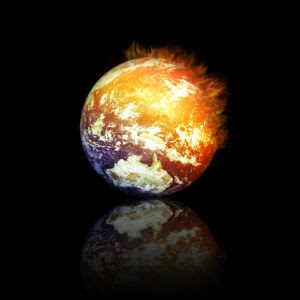Carbon Dioxide: A-Z of Global Warming
 Copyright © 2008 Simon Rosser
Copyright © 2008 Simon RosserWe are now well into our alphabetic A to Z journey on global warming. C for Carbon dioxide is one of the main players in the global warming problem. Carbon dioxide, chemical symbol co2 is a chemical compound composed of one carbon and two oxygen atoms.
CO2 is present in the Earth's atmosphere at a low concentration, around 0.038% by volume, and is one of many gases that make up Earth's atmosphere. CO2 is measured in parts per million by volume of air (PPMV). Atmospheric carbon dioxide derives from many natural sources including volcanic eruptions, the combustion of organic matter, the respiration of living aerobic organisms, and unfortunately from manmade (anthropogenic) sources, which we all know from the news is being linked to global warming and climate change.
 Since the industrial revolution particularly the mid nineteenth century, the burning of fossil fuels for energy to provide electricity, power factories, homes and for all our transport needs has released massive amounts of carbon dioxide (CO2) into the atmosphere. Not only the burning of fossil fuels, but changes in the use of the land for agriculture and deforestation has further added to global manmade CO2 levels. According to the World Wildlife fund some 29 gigatons which is 29 billion metric tons of CO2 was added to the atmosphere in 2004 alone from burning coal, oil and gas.
Since the industrial revolution particularly the mid nineteenth century, the burning of fossil fuels for energy to provide electricity, power factories, homes and for all our transport needs has released massive amounts of carbon dioxide (CO2) into the atmosphere. Not only the burning of fossil fuels, but changes in the use of the land for agriculture and deforestation has further added to global manmade CO2 levels. According to the World Wildlife fund some 29 gigatons which is 29 billion metric tons of CO2 was added to the atmosphere in 2004 alone from burning coal, oil and gas.If we go back 250 years or so, to pre- industrial times, usually taken to be around 1750, CO2 levels in the atmosphere stood at around 280 parts per million by volume (ppmv). However levels of the gas have been increasing steadily ever since.
HOW DO WE KNOW THIS?
Well, pioneering scientist Charles Keeling (1928-2005) started taking atmospheric CO2 measurements in 1958 from Mauna Loa volcano in Hawaii. Those measurements have been recorded and are now known as The Keeling Curve. Charles Keeling was the professor of oceanography at the Scripps Institute of Oceanography (SIO) which is in San Diego, USA, and he followed the work of another eminent scientist and director of the SIO, Roger Revelle. Dr Revelle was instrumental in creating the Geophysical Year in 1958 and SIO's first programme looking at atmospheric CO2 back in 1956.
Monthly CO2 measurements were collected from a height of 3397 metres (11,140 feet) at the Mauna Loa Observatory situated on the slopes of Earth's largest volcano, Mauna Loa in Hawaii which was chosen for its remoteness to populations and vegetation so as not to skewer the readings.
Measurements have been taken over a 50 year period between 1958 and present, which show an increase in CO2 levels of 70 ppmv from around 315 ppmv to around their current level of 385 ppmv. The effects of CO2 in the atmosphere can even be measured on a cyclical basis, and this can be seen in the saw toothed keeling graph. Because there is greater land area, and thus far more plant life in the Northern Hemisphere compared to the Southern Hemisphere, there is an annual fluctuation of about 5 ppmv peaking in May and reaching a minimum in October. This corresponds to the Northern Hemisphere growing season. The amount of CO2 in the atmosphere drops towards spring when uptake by the plants and trees by photosynthesis is greatest. The opposite occurs in winter when the plants die off and CO2 levels rise again.
Continuous readings in this way have only been taken since 1958, however scientists have discovered that prior to the industrial era, circa 1750, CO2 levels stood at around 280 ppmv and this data has been revealed from air trapped in ice core records, taken from both the Antarctic and Arctic. Perhaps most startling is the fact that CO2 levels are now around 85 ppmv higher than at any time during the last 650,000 years. Records from ice core records go back that far and have shown atmospheric CO2 levels to range from 180-300 ppmv during that period. The level of CO2 in our atmosphere now stands at 385 ppmv, and is increasing steadily.
The Keeling curve has become one of the most recognisable images in modern science as it shows with no uncertainty the effects of humankind's fossil fuel pollution of Earth's atmosphere.
CO2 levels have increased by 37% since pre-industrial times and have been increasing by an average of almost 1.4 ppmv a year since measurements began in 1958, although some months the figure has been higher, sometimes lower. In the last ten years however, the average increase appears to be around 1.9 ppmv each year, which indicates the rate of increase is increasing.
Whilst CO2 is a natural greenhouse gas, and important in natural concentrations to maintain Earth's climate, anthropogenic CO2 is now pushing up Earth's temperature. Earth's natural sinks, like the Amazon rainforest and the oceans struggle to absorb the additional CO2 now being
 added to the atmosphere from the burning of fossil fuels. It is a know scientific fact that higher levels of greenhouse gases, of which CO2 is a component cause a warming of Earth's atmosphere. If CO2 is not kept in check and continues to rise at current levels it will eventually cause Earth's temperature to increase to levels which maybe critical to life on Earth.
added to the atmosphere from the burning of fossil fuels. It is a know scientific fact that higher levels of greenhouse gases, of which CO2 is a component cause a warming of Earth's atmosphere. If CO2 is not kept in check and continues to rise at current levels it will eventually cause Earth's temperature to increase to levels which maybe critical to life on Earth.Earth's temperature has already increased by 0.74 degrees Celsius (1.33 Fahrenheit ) over the last 100 years......
------------------------
Simon Rosser, a lawyer by profession, I felt inspired to write The A-Z of Global Warming, published in June 2008, after viewing Al Gore's documentary, An Inconvenient Truth in Nov 2006. Based on the most upto date scientific information, this Carbon Dioxide extract gives a flavour of the books content. To pre-order the book from Amazon, goto
http://www.amazon.co.uk/Z-Global-Warming-Simon-Rosser/dp/0955809207/ref=sr_1_9?ie=UTF8&s=books&qid=1206442671&sr=1-9
Labels: carbon dioxide, climate change, co2, earth's atmosphere, effects of co2, fossil fuel pollution, global warming, global warming problem, industrial revolution, keeling curve, natural greenhouse gas


0 Comments:
Post a Comment
Join the Mailing list, get Daily Love Quote in Your Email and get a Free copy of "What is Love?" movie. The name and email address collected are not sold, given, or in any way disclosed to a third party. We will never give out your email address.
<< Home